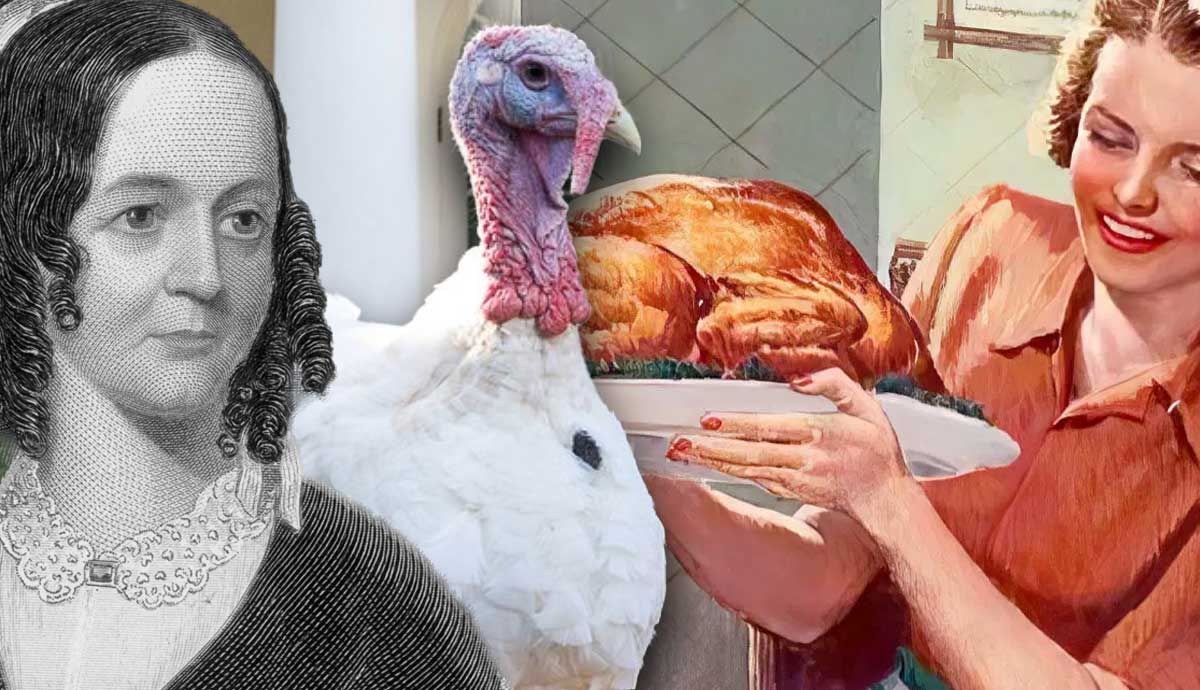
Thanksgiving is typically associated with a family-sized feast of hearty foods including cranberry sauce, pumpkin pie, bread stuffing, and mashed potatoes, which are all satellites around the central focus: the roast turkey. In fact, figures suggest around 45 to 46 million turkeys are consumed during Thanksgiving every year. But how did turkey become such a central part of the Thanksgiving tradition?
Turkey Was Not Always a Thanksgiving Staple

Historians now believe turkey wasn’t actually consumed during what was often cited as the first Thanksgiving meal between the Pilgrim settlers and the Wampanoag tribe in 1621. Instead, it has been suggested they ate deer, along with other wild fowl, such as goose or duck. In fact, it wasn’t until the 19th century that turkey became embedded within the Thanksgiving feast that sits atop tables across the United States and Canada. We track the origins of this national dish, which is bound within American history.
Turkey Became a National Dish During the 19th Century

At the turn of the 19th century, turkey was fast becoming a popular dish for families, particularly within North America, where the bird was indigenous. There were several reasons why turkey became so popular during this time; for one, turkeys were plentiful across North America, making them easy prey for farming families. Turkeys raised on farms were generally kept solely for the purpose of becoming meat, as unlike cows and chickens they could not produce any secondary products (milk and eggs). Farmed turkeys could also grow to generous sizes, making them a popular choice for large family gatherings, as they could easily feed an entire family.
Sarah Josepha Hale: The Woman Who Made Thanksgiving a National Holiday

Many of the Thanksgiving traditions we now know today owe a debt to the American writer and lobbyist Sarah Josepha Hale, who spent years campaigning for Thanksgiving to become a national day of celebration, arguing that it would unify a country on the brink of war. It was thanks to her hard work that President Abraham Lincoln eventually proclaimed the public holiday in 1863, to take place on the fourth Thursday of each November. Her dedication means Hale is often referred to as the “Mother of Thanksgiving.”
Hale also wrote about the traditional Thanksgiving meal in her 1827 novel Northwood, describing a New England Thanksgiving meal with a large roasted turkey placed at the head of the table, creating a blueprint of the ideal family gathering that would persist throughout the minds of Americans for centuries. Hale assumed the early settlers would have shared turkey with the Wampanoag tribe, and although her theory has been largely dismissed, the turkey remained a stalwart center of the Thanksgiving meal.
Migration from New England: How Turkey Became the Thanksgiving Tradition

Ashley Young, a historian from the Smithsonian National Museum of American History, argued in a recent interview that one of the core reasons why turkey became so embedded within the cultural consciousness was because of migration from New England, where the bird was plentiful and popular. As Americans gradually spread across the American west, she explained, they brought with them their traditional foods and harvest festivals. Turkey farming became widespread across all areas of the US, and the bird’s popularity spread exponentially.
A National Dish for a Unified Nation

Following Abraham Lincoln’s decree, Thanksgiving became accepted as a traditional celebration across much of the United States during the mid-19th century. The humble turkey became a key part of unifying the nation for this annual celebration, setting the Americans apart from other nations, many of whom already had entrenched culinary traditions going back many centuries, or even millennia. Over time, the tradition for gathering to eat turkey became embedded within the American national mythology.
The Typical American Thanksgiving Feast

The typical American thanksgiving feast has changed over the years. While turkey is usually a central part of the feast, Thanksgiving dinner varies regionally and among groups of Americans with different backgrounds. Above are three different examples of Thanksgiving feasts. On the left is a postcard from c. 1910 depicting typical Thanksgiving feast offerings including turkey, fish, and pumpkin pie. In the middle is a classic thanksgiving plate by Martha Stewart, an American businesswoman, homemaker, and television personality from New Jersey. On the right is a New England Thanksgiving menu served in Falmouth, Maine in 2005. All of these menus contain turkey, but they have their own flair as well.
Presidential Turkeys & Modern Turkey Traditions

The tradition of gifting turkeys to the American president began during the 1870s, when the poultry dealer Horace Vose generously shared his largest birds with the presidential family on Thanksgiving and other festive days. Following his precedent, several dealers continued the practice over the years, and such gifts became a ceremonial act of national importance.
Another curious turkey tradition also emerged more recently; the Presidential Pardoning of the Thanksgiving Turkey. In 1963, President John F Kennedy was gifted a turkey bearing a sign around its neck reading “Good eating, Mr. President.” In response, Kennedy returned the turkey to the farm, famously quipping, “let’s let this one go.” Since then, each president has since bestowed a pardon on one or two carefully chosen turkeys every year, in response to ardent animal rights activists.
Traditional Foods for Canadian Thanksgiving

Many Americans don’t realize that Canada also celebrates Thanksgiving on the second Monday of October every year. Canadians eat many similar foods to Americans for Thanksgiving, with many eating a slightly more subdued feast featuring turkey, mashed potatoes, and cranberry sauce, and spiced pumpkin pie.
Like in the United States, the Canadian Thanksgiving feast also varies by region. In Newfoundland, many eat “Jiggs Dinner” on Thanksgiving, consisting of split pea pudding and boiled meat. In coastal areas, Thanksgiving meals in Canada often have ham and seafood as part of the dinner. Even though Canadian Thanksgiving has separate origins from the American holiday, many still associate the celebration heavily with Turkey.










